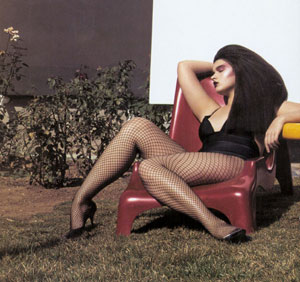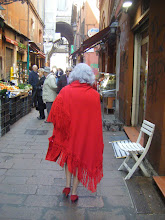 I used to think that politics and religion were the most taboo subjects, but apparently the most controversial subject- at least when it comes to fashion these days- is that of shape. I forget when the age-old thin/plus-size debate was reinvigorated, but the debate seems to have reached an all-time high. Glamour has featured nude "plus-size" models. V has paired a plus-size model with a thin model. Robin Givhan has discussed the issue in both The Washington Post and NPR. If you follow fashion closely, this debate is inescapable. It's really a shame, too, because this is really one of the least important aspects of the industry, in my opinion. I've tried to overlook this and just focus on what I love about fashion, but, alas, I no longer can. So, please, allow me just this one little rant.
I used to think that politics and religion were the most taboo subjects, but apparently the most controversial subject- at least when it comes to fashion these days- is that of shape. I forget when the age-old thin/plus-size debate was reinvigorated, but the debate seems to have reached an all-time high. Glamour has featured nude "plus-size" models. V has paired a plus-size model with a thin model. Robin Givhan has discussed the issue in both The Washington Post and NPR. If you follow fashion closely, this debate is inescapable. It's really a shame, too, because this is really one of the least important aspects of the industry, in my opinion. I've tried to overlook this and just focus on what I love about fashion, but, alas, I no longer can. So, please, allow me just this one little rant.My main criticism of this dialogue comparing thin (or "skinny") models with plus-size models is this notion that plus-size models are "real" women and only plus-size models are "real" women. I'm so tired of hearing phrases like "real women have curves" or "this is what real women look like." I may be a size zero, but I assure you that I have a pulse. I am a "real" woman, too. Newsflash: "real" women come in all shapes, sizes, colors, heights, races, etc, etc. It is very offensive and unnecessary to pin-point one shape or size as the defining characteristic of what constitutes "real" women.
Vogue should understand this wrath better than any publication. No other issue throughout the year incites more rage than the annual "Shape Issue." Year after year, readers write in complaining that the Shape Issue misrepresents women, that the magazine failed to recognize a reader's personal shape or size, and that there are more sizes than Vogue features. Vogue breaks the shapes down into the following dimensions: tall, short, thin, curvy, athletic, and pregnant. How could any person on the planet not fall into one of those categories? In my estimation, a person can be a combination of body types (i.e. short and pregnant, tall and curvy, pregnant and athletic), or a person could be between shapes (i.e. not tall enough to be considered "tall" or not exactly curvy either). Nevertheless, the Vogue editors and writers get their heads chewed off for failing to recognize one shape or another, despite their best attempt at being all-inclusive. You think they would learn their lesson and not even bother with the obligatory Shape Issue. Stay tuned after the April 2010 issue is released for a run-down on this year's criticism...
My other complaint here is that plus-size women are assumed to be the more pleasing body type to men. Well, if women come in all shapes and sizes, wouldn't it be possible that there is a man out there who likes each possible body type? No, apparently. Only Crystal Renn is attractive to men. Forget Carmen Kass, Natalia, Linda V, Liya Kebede, et al. If you're not plus-size, men aren't interested. Even Giselle, the girl Rolling Stone once deemed "the most beautiful girl in the world," is not appealing to men (well, aside from Tom Brady). How is it helpful to try to deduce what body type is better than another? Isn't this harmful to thin girls? Making them believe that as long as they are thin, they won't be attractive to the opposite sex? This seems just as harmful to me as convincing women that they must lose weight in order to be attractive.
And, finally, could we stop referring to thin girls as "skinny?" "Skinny" used to have a negative connotation and I believe that it still does, just like "fat" or "overweight" are shunned in favor of the more politically correct "plus size." "Skinny" is not a complimentary word.
With that being said, could the magazines just leave this issue alone? Could they feature beautiful models regardless of their shape without drawing attention to one body type or another by featuring certain models nude? Stop pointing fingers and using labels. Just feature beautiful, lively, healthy models and readers will be happy.
Segregation should not be happening in 2010. I'll rely on Anna to take the lead in breaking down this barrier.
OK, rant over.

This really interesting. And since I've been both places, maybe I can shed some light? (if not I"m just commenting)
ReplyDeleteWhen I was in college, I was a size 0, and I had people tell me, "oh, you need curves" or "you need hips" or whatever. Yes, it was annoying.
I think the "men like bigger women" thing is partially a self-esteem booster for people who aren't a size 0. And I'm not a size 0 anymore--my first reaction upon seeing some of these models is, "For the love of God, EAT SOMEHTHING!" But then I have aunts who have had three children and are still really tiny. Genetics at work.
Another part of it could be that a lot of women may START at 0 or 2 or whatever, and then they have kids. Breasts get bigger, hips are bigger, it's just all bigger. (LIke Scarlett in Gone With the Wind) So they feel like they're not attractive anymore.
Media is so subjective this way--what is attractive to one editor is distasteful to another. Even "plus-size" is up for debate--what does that mean? A 10? A 16? The sizes they have at Lane Bryant?
I don't know if any of this made any sense--just my thoughts.